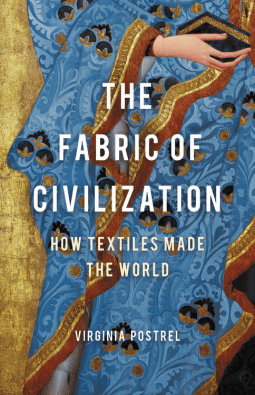The back cover copy of The Fabric of Civilization, by Virginia Postel, does it’s best to summarise the extent of the amazing and diverse journey the reader goes on when picking it up but still, I was astonished by just how much is packed succinctly into this book! The 320 pages are intense but I loved it!
Broken into seven chapters, it begins with “Fiber”, next is “Thread”, this goes onto “Cloth”, through “Dye” before arriving at “Traders” and “Consumers”. The final chapter digs into “Innovators”. Every chapter has subsections which unpack the history of the world through textiles. From ancient civilizations through to 3D printing and beyond, it’s easy to understand and yet, surprising and fascinating to see this thread which weaves through history.
My family has heritage in textiles both in the weaving and trading which goes back generations so I found this connection interesting especially as myself and my cousins are into computers and programming “…the connection between weaving a textile fabric and designing a computer system is a close one”.
Amongst the facts are stories of current and past textile creators and innovators, what drove their discoveries and how they overcame challenges. From creating the perfect dye to improving silk production, adopting better manufacturing process and transferring skills, textiles have faced and tackled all the major business barriers and, for the most part, been improved by the challenge.
“Suffering from a chronic shortage of coin, especially in the rural areas, the Tang Dynasty (618-907 CE) encouraged textiles as an alternative. In 732, the government declared bolts of hemp and silk to be legal tender…Coins served as accounting units but bolts of cloth were the everyday medium of exchange.” This tidbit captivated me, imagine going shopping with your fabric! The banking industry has it’s roots in textiles…my Mum used to work for a bank, now we can call it the family trade! The entire trading process explains a lot of the new world expansion as well as the drive to find new materials and dyes. Cross-pollination of plants, processes and dyes came at a cost and there was huge money (or bolts) to be made by those in the know.
As always, the customer dictates what is made, what is valued and what is developed. “The cultural authenticity of cloth arises not from the purity of its origins but from the ways which individuals and groups turn textiles into their own purposes. Consumers, not producers, determine the meaning and value of textiles. Cloth is ubiquitous and adaptable, forever evolving in for and meaning. Trying to impose an external standard, heedless of consumers’ beliefs and desires, is not merely futile but disrespectful and absurd.” Such wisdom, beyond textiles, for marketing of products and services!
Now “customers still want clothes to be attractive, comfortable, and reasonably priced. But ecofriendliness has become fashionable.” The sections on development to make this happen are intriguing and exciting! I look forward to seeing what becomes viable for mass production!
In a book that continually reminded me of my family, these lines made me giggle because my Nan loved her synthetics and drip-dry and now I know why! “They liberated women from household drudgery. Curtains that could be drip dried, uniforms that never needed ironing, and sweaters that be washed without shrinking reduced domestic burdens”
If you love history, interesting facts, engineering or product development, this is a fabulous book! Of course, if you’re into textiles, this is one you can’t miss out on! I highly recommend it, five out of five on the enJOYment scale!

From the back cover:
From Paleolithic flax to 3D knitting, explore the global history of textiles and the world they weave together in this enthralling and educational guide. The story of humanity is the story of textiles — as old as civilization itself. Since the first thread was spun, the need for textiles has driven technology, business, politics, and culture.
In The Fabric of Civilization, Virginia Postrel synthesizes groundbreaking research from archaeology, economics, and science to reveal a surprising history. From Minoans exporting wool colored with precious purple dye to Egypt, to Romans arrayed in costly Chinese silk, the cloth trade paved the crossroads of the ancient world. Textiles funded the Renaissance and the Mughal Empire; they gave us banks and bookkeeping, Michelangelo’s David and the Taj Mahal. The cloth business spread the alphabet and arithmetic, propelled chemical research, and taught people to think in binary code.
Assiduously researched and deftly narrated, The Fabric of Civilization tells the story of the world’s most influential commodity.
I received a complimentary copy of the book from Perseus Books through NetGalley. Opinions expressed in this review are completely my own.

